check engine CITROEN BERLINGO VAN 2019 Handbook (in English)
[x] Cancel search | Manufacturer: CITROEN, Model Year: 2019, Model line: BERLINGO VAN, Model: CITROEN BERLINGO VAN 2019Pages: 320, PDF Size: 8.91 MB
Page 5 of 320
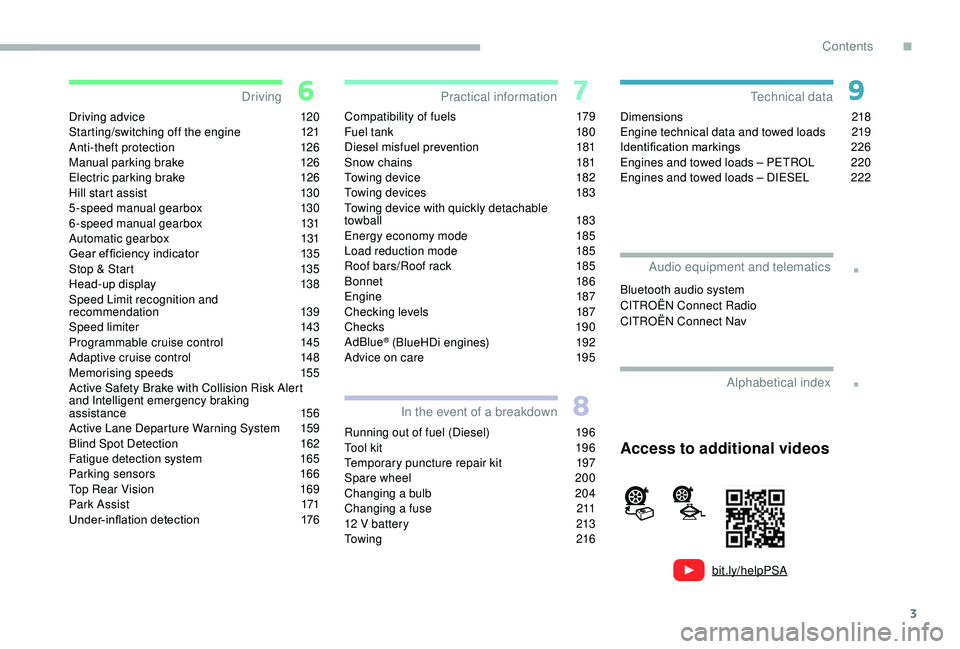
3
bit.ly/helpPSA
.
.
Driving advice 120
Starting/switching off the engine 1 21
Anti-theft protection
1
26
Manual parking brake
1
26
Electric parking brake
1
26
Hill start assist
1
30
5-speed manual gearbox
1
30
6-speed manual gearbox
1
31
Automatic gearbox
1
31
Gear ef ficiency indicator
1
35
Stop & Start
1
35
Head-up display
1
38
Speed Limit recognition and
recommendation
139
Speed limiter
1
43
Programmable cruise control
1
45
Adaptive cruise control
1
48
Memorising speeds
1
55
Active Safety Brake with Collision Risk Alert
and Intelligent emergency braking
assistance
1
56
Active Lane Departure Warning System
1
59
Blind Spot Detection
1
62
Fatigue detection system
1
65
Parking sensors
1
66
Top Rear Vision
1
69
Park Assist
1
71
Under-inflation detection
1
76Compatibility of fuels 1
79
Fuel tank 1 80
Diesel misfuel prevention
1
81
Snow chains
1
81
Towing device
1
82
Towing devices
1
83
Towing device with quickly detachable
towball
183
Energy economy mode
1
85
Load reduction mode
1
85
Roof bars/Roof rack
1
85
Bonnet
18
6
Engine
187
Checking levels
1
87
Checks
19
0
AdBlue
® (BlueHDi engines) 1 92
Advice on care 1 95
Running out of fuel (Diesel)
1
96
Tool kit
1
96
Temporary puncture repair kit
1
97
Spare wheel
20
0
Changing a bulb
2
04
Changing a fuse
2
11
12
V battery
2
13
To w i n g
2 16Dimensions
218
Engine technical data and towed loads
2
19
Identification markings
2
26
Engines and towed loads – PETROL
2
20
Engines and towed loads – DIESEL
2
22
Driving
Practical information
In the event of a breakdown Technical data
Access to additional videos
Alphabetical index
Audio equipment and telematics
Bluetooth audio system
CITROËN Connect Radio
CITROËN Connect Nav
.
Contents
Page 11 of 320
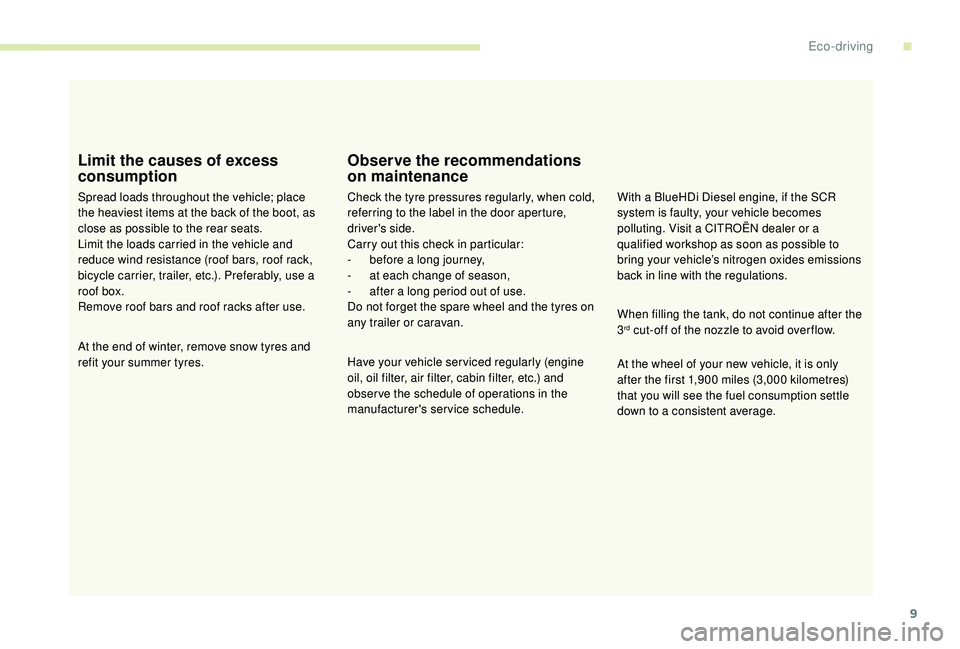
9
Limit the causes of excess
consumption
Spread loads throughout the vehicle; place
the heaviest items at the back of the boot, as
close as possible to the rear seats.
Limit the loads carried in the vehicle and
reduce wind resistance (roof bars, roof rack,
bicycle carrier, trailer, etc.). Preferably, use a
roof box.
Remove roof bars and roof racks after use.
At the end of winter, remove snow tyres and
refit your summer tyres.
Observe the recommendations
on maintenance
Check the tyre pressures regularly, when cold,
referring to the label in the door aperture,
driver's side.
Carry out this check in particular:
-
b
efore a long journey,
-
a
t each change of season,
-
a
fter a long period out of use.
Do not forget the spare wheel and the tyres on
any trailer or caravan.
Have your vehicle ser viced regularly (engine
oil, oil filter, air filter, cabin filter, etc.) and
obser ve the schedule of operations in the
manufacturer's service schedule. When filling the tank, do not continue after the
3
rd cut-off of the nozzle to avoid over flow.
At the wheel of your new vehicle, it is only
after the first 1,900
miles (3,000 kilometres)
that you will see the fuel consumption settle
down to a consistent average. With a BlueHDi Diesel engine, if the SCR
system is faulty, your vehicle becomes
polluting. Visit a CITROËN dealer or a
qualified workshop as soon as possible to
bring your vehicle’s nitrogen oxides emissions
back in line with the regulations.
.
.
Eco-drivingsommaire
Page 20 of 320

18
Diesel engine pre-
heatingFixed.
The period of
illumination depends on
the climatic conditions.The ignition is on.Wait until the warning lamp goes off before starting.
If the engine does not start, switch the ignition off and
then on, wait until the lamp goes off again, then start
the engine.
Warning/indicator lamp
StateCause Actions/Observations
Under-inflation Fixed, accompanied
by an audible signal
and a message. The pressure in one or more
wheels is too low.
Check the pressure of the tyres as soon as possible.
Reinitialise the detection system after adjusting the
pressure.
+ Under-inflation
warning lamp flashing
then fixed and Ser vice
warning lamp fixed.The system is faulty: tyre
pressures are no longer
monitored.
As soon as possible, check the pressure of the tyres
and carry out (3).
Anti-lock braking
system (ABS) Fixed.
The anti-lock braking system has
a fault. The vehicle retains conventional braking.
Drive carefully at moderate speed, then carry out (3).
Collision Risk
Aler t /Active Safety
Brake Fixed, accompanied
by the display of a
message. The system has been deactivated
via the vehicle configuration
menu.
Flashing. The system is operating. The vehicle brakes briefly so as to reduce the speed of
collision with the vehicle ahead.
Fixed, accompanied
by a message and an
audible signal. The system has a fault.
Carry out (3).
+ Collision Risk
Aler t /Active Safety
Brake
Fixed.
The system has a fault. If these lamps come on after the engine is switched
off and restarted, carry out (3).
Instruments
Page 32 of 320
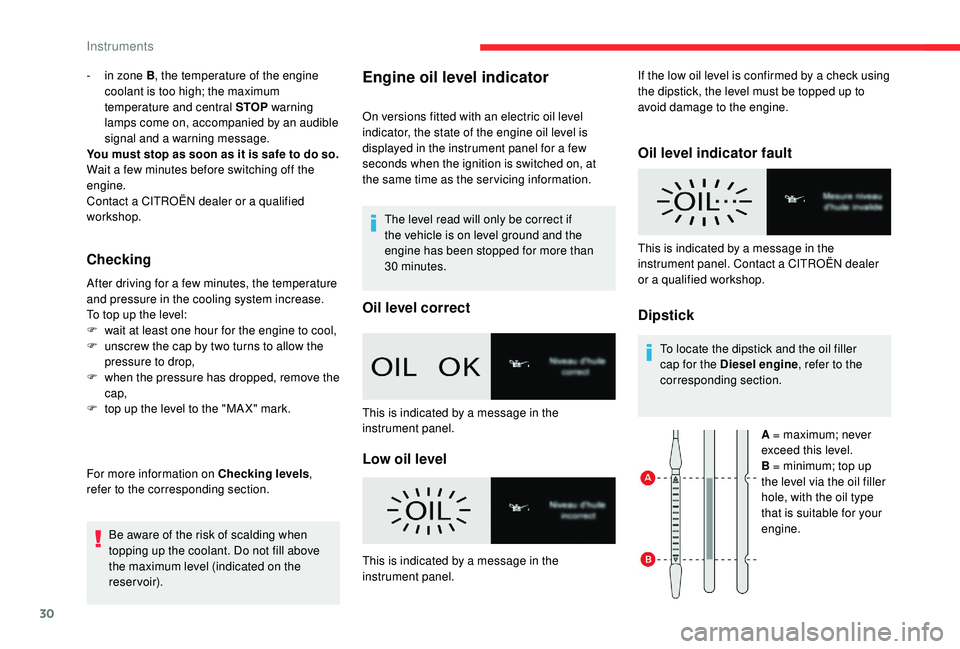
30
- in zone B, the temperature of the engine
coolant is too high; the maximum
temperature and central STOP warning
lamps come on, accompanied by an audible
signal and a warning message.
You must stop as soon as it is safe to do so.
Wait a few minutes before switching off the
engine.
Contact a CITROËN dealer or a qualified
workshop.
Checking
After driving for a few minutes, the temperature
and pressure in the cooling system increase.
To top up the level:
F
w
ait at least one hour for the engine to cool,
F
u
nscrew the cap by two turns to allow the
pressure to drop,
F
w
hen the pressure has dropped, remove the
cap,
F
t
op up the level to the "MA X" mark.
For more information on Checking levels ,
refer to the corresponding section.
Be aware of the risk of scalding when
topping up the coolant. Do not fill above
the maximum level (indicated on the
reservoir).
Engine oil level indicator
On versions fitted with an electric oil level
indicator, the state of the engine oil level is
displayed in the instrument panel for a few
seconds when the ignition is switched on, at
the same time as the ser vicing information.The level read will only be correct if
the vehicle is on level ground and the
engine has been stopped for more than
30
minutes.
Oil level correct
This is indicated by a message in the
instrument panel.
Low oil level
If the low oil level is confirmed by a check using
the dipstick, the level must be topped up to
avoid damage to the engine.
This is indicated by a message in the
instrument panel.
Oil level indicator fault
Dipstick
To locate the dipstick and the oil filler
cap for the Diesel engine , refer to the
corresponding section.
A = maximum; never
exceed this level.
B = minimum; top up
the level via the oil filler
hole, with the oil type
that is suitable for your
engine.
This is indicated by a message in the
instrument panel. Contact a CITROËN dealer
or a qualified workshop.
Instruments
Page 34 of 320
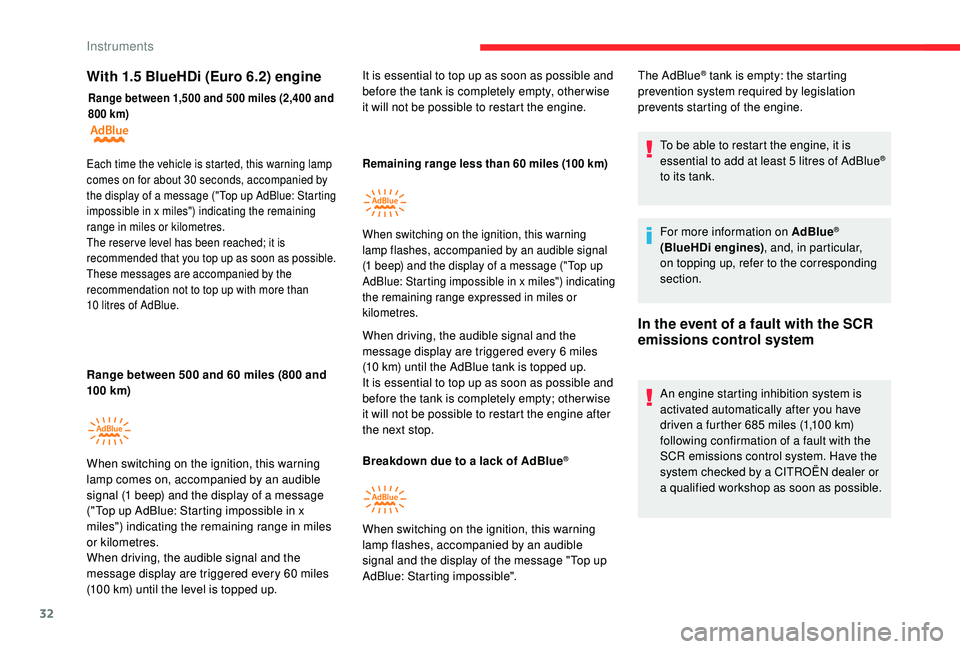
32
With 1.5 BlueHDi (Euro 6.2) engine
Range between 1,500 and 500 miles (2,400 and
8 00 km)
Range between 500 and 60 miles (800 and
10 0 km)
Remaining range less than 60 miles (100 km)
When driving, the audible signal and the
message display are triggered every 6 miles
(10
km) until the AdBlue tank is topped up.
It is essential to top up as soon as possible and
before the tank is completely empty; other wise
it will not be possible to restart the engine after
the next stop.
Breakdown due to a lack of AdBlue
®
The AdBlue® tank is empty: the starting
prevention system required by legislation
prevents starting of the engine.
To be able to restart the engine, it is
essential to add at least 5
litres of AdBlue
®
to its tank.
For more information on AdBlue
®
(BlueHDi engines) , and, in particular,
on topping up, refer to the corresponding
section.
Each time the vehicle is started, this warning lamp
c omes on for about 30 seconds, accompanied by
the display of a message ("Top up AdBlue: Starting
impossible in x miles") indicating the remaining
range in miles or kilometres.
The reser ve level has been reached; it is
recommended that you top up as soon as possible.
These messages are accompanied by the
recommendation not to top up with more than
10
litres of AdBlue.
When switching on the ignition, this warning
l amp comes on, accompanied by an audible
signal (1 beep) and the display of a message
("Top up AdBlue: Starting impossible in x
miles") indicating the remaining range in miles
or kilometres.
When driving, the audible signal and the
message display are triggered every 60
miles
(100
km) until the level is topped up. It is essential to top up as soon as possible and
before the tank is completely empty, other wise
it will not be possible to restart the engine.
When switching on the ignition, this warning
lam p flashes, accompanied by an audible signal
(1 beep) and the display of a message ("Top up
AdBlue: Starting impossible in x miles") indicating
the remaining range expressed in miles or
kilometres.
When switching on the ignition, this warning
lamp flashes, accompanied by an audible
signal and the display of the message "Top up
AdBlue: Starting impossible".
In the event of a fault with the SCR
emissions control system
An engine starting inhibition system is
activated automatically after you have
driven a further 685
miles (1,100 km)
following confirmation of a fault with the
SCR emissions control system. Have the
system checked by a CITROËN dealer or
a qualified workshop as soon as possible.
Instruments
Page 35 of 320

33
In the event of the detection of a faultIf it is a temporary fault, the alert
disappears during the next journey,
after self-diagnostic checks of the SCR
emissions control system.
These warning lamps come on, accompanied
by an audible signal and the display of the
message "Emissions fault".
The alert is triggered while driving as soon
as the fault is detected for the first time, then
when switching on the ignition for subsequent
journeys, while the fault persists.
During the permitted driving phase (between
685 and 0
miles (1,100 km and 0 km))
While driving, the message is displayed every
30 seconds while the fault with the SCR
emissions control system persists.
The alert is repeated when switching on the
ignition.
You should go to a CITROËN dealer or a
qualified workshop as soon as possible.
Other wise you will not be able to restart the
vehicle.
(e.g. "Emissions fault: Starting prevented in
300 miles") indicating the remaining range
expressed in miles or kilometres.
If a fault with the SCR system is confirmed
(after around 30 miles (50 km) covered with the
permanent display of the message signalling
a fault), these warning lamps come on and the
AdBlue warning lamp flashes, accompanied by
an audible signal and the display of a message
Starting prevented You have exceeded the authorised driving
limit: the starting prevention system does
not allow the engine to be started.
To be able to restart the engine, you must call
on a CITROËN dealer or a qualified workshop. Each time the ignition is switched on, these
warning lamps come on and the AdBlue
warning lamp flashes, accompanied by an
audible signal and the display of the message
"Emissions fault: Starting prevented".
Lighting dimmer
Permits manual adjustment of the brightness
of the instrument panel to suit the exterior light
level.
With the lamps on, press button A to increase
the brightness of the instruments and controls
and the vehicle’s ambient lighting or button B
to reduce it.
Release the button when the desired level is
reached.
1
Instruments
Page 51 of 320
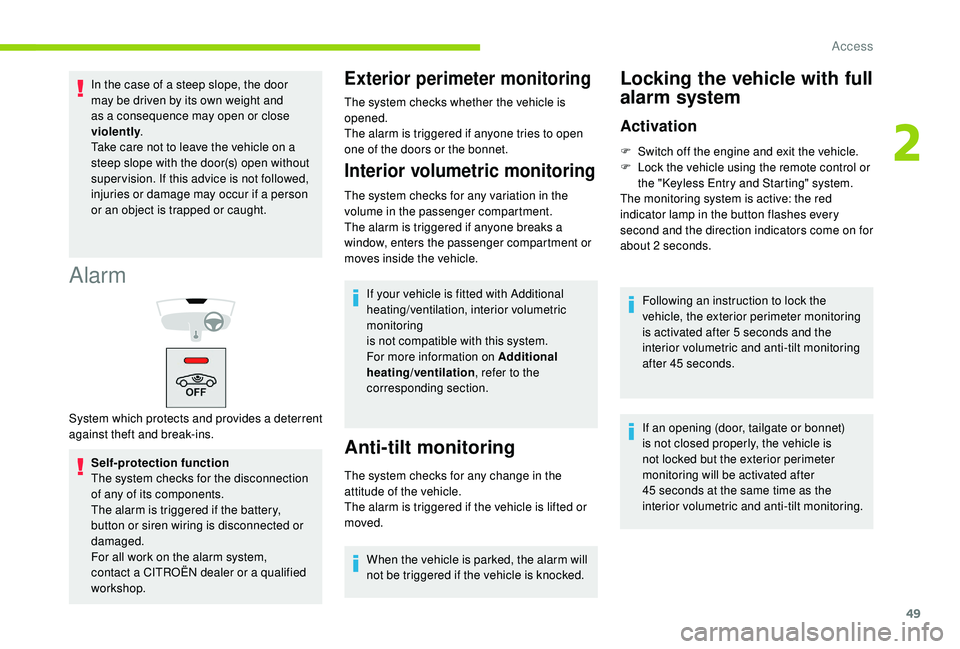
49
Alarm
Self-protection function
The system checks for the disconnection
of any of its components.
The alarm is triggered if the battery,
button or siren wiring is disconnected or
damaged.
For all work on the alarm system,
contact a CITROËN dealer or a qualified
workshop.
Exterior perimeter monitoring
The system checks whether the vehicle is
opened.
The alarm is triggered if anyone tries to open
one of the doors or the bonnet.
Interior volumetric monitoring
The system checks for any variation in the
volume in the passenger compartment.
The alarm is triggered if anyone breaks a
window, enters the passenger compartment or
moves inside the vehicle.If your vehicle is fitted with Additional
heating/ventilation, interior volumetric
monitoring
is not compatible with this system.
For more information on Additional
heating/ventilation , refer to the
corresponding section.
Anti-tilt monitoring Locking the vehicle with full
alarm system
Activation
Following an instruction to lock the
vehicle, the exterior perimeter monitoring
is activated after 5
seconds and the
interior volumetric and anti-tilt monitoring
after 45
seconds.
If an opening (door, tailgate or bonnet)
is not closed properly, the vehicle is
not locked but the exterior perimeter
monitoring will be activated after
45
seconds at the same time as the
interior volumetric and anti-tilt monitoring.
In the case of a steep slope, the door
may be driven by its own weight and
as a consequence may open or close
violently
.
Take care not to leave the vehicle on a
steep slope with the door(s) open without
supervision. If this advice is not followed,
injuries or damage may occur if a person
or an object is trapped or caught.
The system checks for any change in the
attitude of the vehicle.
The alarm is triggered if the vehicle is lifted or
moved.When the vehicle is parked, the alarm will
not be triggered if the vehicle is knocked. F
S
witch off the engine and exit the vehicle.
F
L
ock the vehicle using the remote control or
the "
K
eyless Entry and Starting" system.
The monitoring system is active: the red
indicator lamp in the button flashes every
second and the direction indicators come on for
about 2
seconds.
System which protects and provides a deterrent
against theft and break-ins.
2
Access
Page 67 of 320
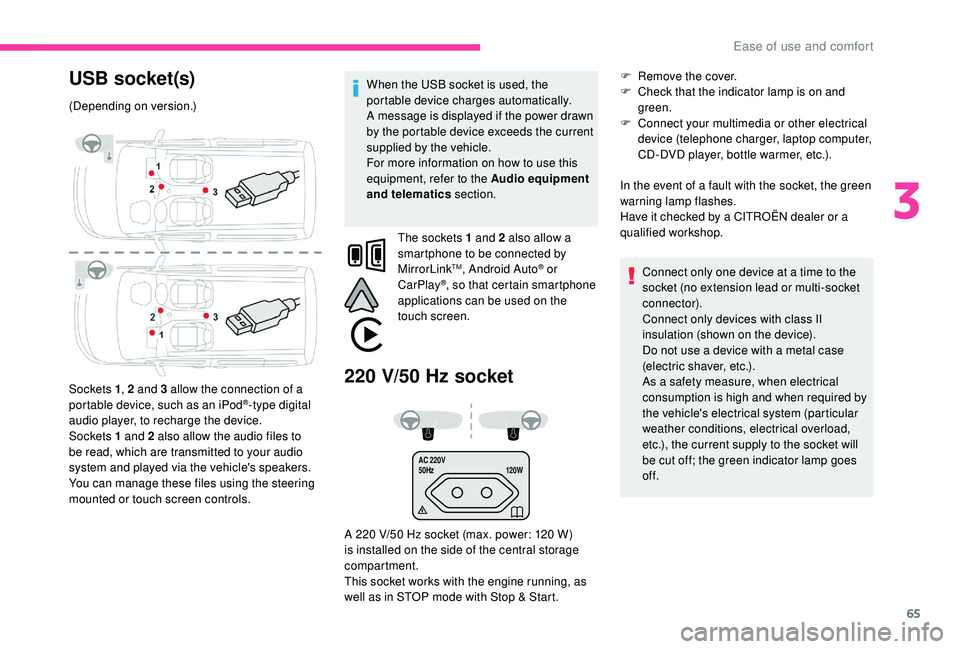
65
AC 220V
50Hz120W
USB socket(s)
(Depending on version.)
Sockets 1, 2 and 3 allow the connection of a
portable device, such as an iPod
®-type digital
audio player, to recharge the device.
Sockets 1 and 2 also allow the audio files to
be read, which are transmitted to your audio
system and played via the vehicle's speakers.
You can manage these files using the steering
mounted or touch screen controls.
220 V/50 Hz socket
A 220 V/50 Hz socket (max. power: 120 W)
i s installed on the side of the central storage
compartment.
This socket works with the engine running, as
well as in STOP mode with Stop & Start. When the USB socket is used, the
portable device charges automatically.
A message is displayed if the power drawn
by the portable device exceeds the current
supplied by the vehicle.
For more information on how to use this
equipment, refer to the Audio equipment
and telematics
section.
The sockets 1 and 2 also allow a
smartphone to be connected by
MirrorLink
TM, Android Auto® or
CarPlay®, so that certain smartphone
applications can be used on the
touch screen. F
R
emove the cover.
F
C
heck that the indicator lamp is on and
green.
F
C
onnect your multimedia or other electrical
device (telephone charger, laptop computer,
CD-DVD player, bottle warmer, etc.).
In the event of a fault with the socket, the green
warning lamp flashes.
Have it checked by a CITROËN dealer or a
qualified workshop.
Connect only one device at a time to the
socket (no extension lead or multi-socket
connector).
Connect only devices with class II
insulation (shown on the device).
Do not use a device with a metal case
(electric shaver, etc.).
As a safety measure, when electrical
consumption is high and when required by
the vehicle's electrical system (particular
weather conditions, electrical overload,
etc.), the current supply to the socket will
be cut off; the green indicator lamp goes
of f.
3
Ease of use and comfort
Page 68 of 320
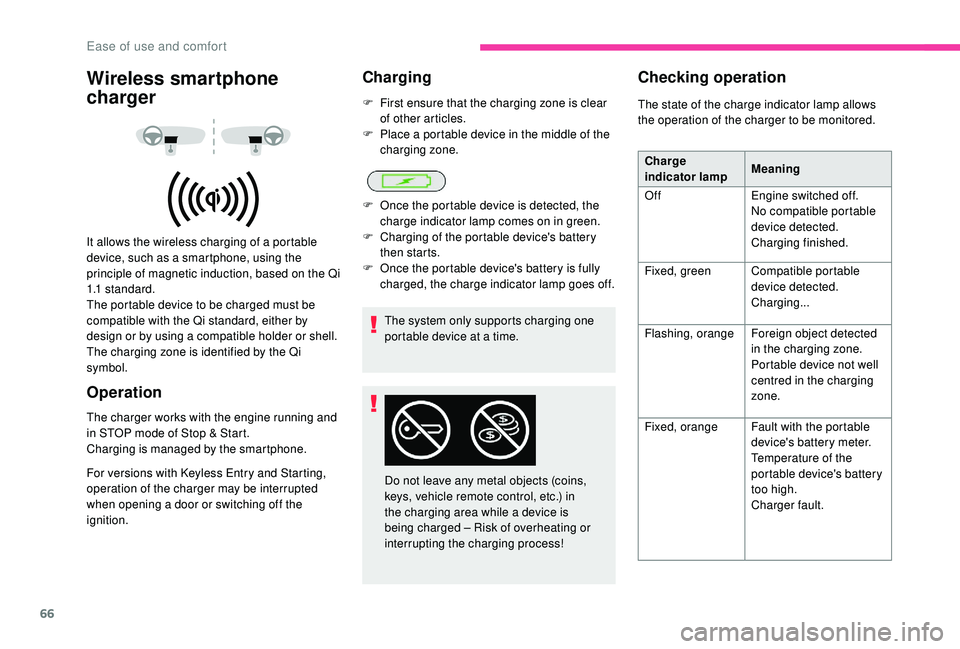
66
Wireless smartphone
charger
It allows the wireless charging of a portable
device, such as a smartphone, using the
principle of magnetic induction, based on the Qi
1.1 standard.
The portable device to be charged must be
compatible with the Qi standard, either by
design or by using a compatible holder or shell.
The charging zone is identified by the Qi
symbol.
Operation
The charger works with the engine running and
in STOP mode of Stop & Start.
Charging is managed by the smartphone.
For versions with
K
eyless Entry and Starting,
operation of the charger may be interrupted
when opening a door or switching off the
ignition.
Charging
F First ensure that the charging zone is clear of other articles.
F
P
lace a portable device in the middle of the
charging zone.
The system only supports charging one
portable device at a time.
F
O
nce the portable device is detected, the
charge indicator lamp comes on in green.
F
C
harging of the portable device's battery
then starts.
F
O
nce the portable device's battery is fully
charged, the charge indicator lamp goes off.
Do not leave any metal objects (coins,
keys, vehicle remote control, etc.) in
the charging area while a device is
being charged – Risk of overheating or
interrupting the charging process!
Checking operation
The state of the charge indicator lamp allows
the operation of the charger to be monitored. Charge
indicator lamp Meaning
Off Engine switched off.
No compatible portable
device detected.
Charging finished.
Fixed, green Compatible portable
device detected.
Charging...
Flashing, orange Foreign object detected
in the charging zone.
Portable device not well
centred in the charging
zone.
Fixed, orange Fault with the portable
device's battery meter.
Temperature of the
portable device's battery
too high.
Charger fault.
Ease of use and comfort
Page 81 of 320
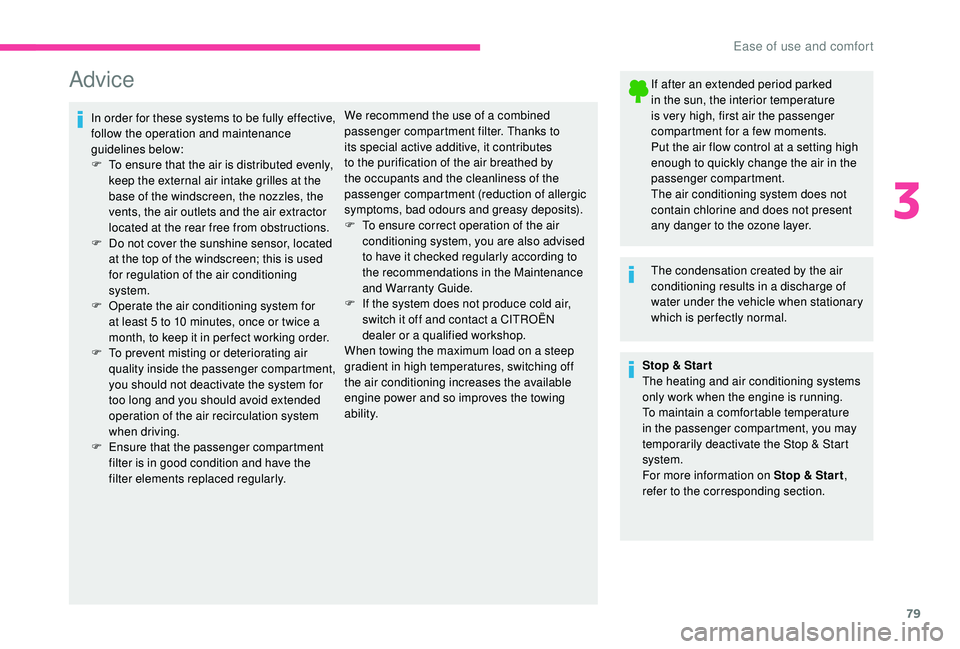
79
Advice
In order for these systems to be fully effective,
follow the operation and maintenance
guidelines below:
F
T
o ensure that the air is distributed evenly,
keep the external air intake grilles at the
base of the windscreen, the nozzles, the
vents, the air outlets and the air extractor
located at the rear free from obstructions.
F
D
o not cover the sunshine sensor, located
at the top of the windscreen; this is used
for regulation of the air conditioning
system.
F
O
perate the air conditioning system for
at least 5 to 10
minutes, once or twice a
month, to keep it in per fect working order.
F
T
o prevent misting or deteriorating air
quality inside the passenger compartment,
you should not deactivate the system for
too long and you should avoid extended
operation of the air recirculation system
when driving.
F
E
nsure that the passenger compartment
filter is in good condition and have the
filter elements replaced regularly. We recommend the use of a combined
passenger compartment filter. Thanks to
its special active additive, it contributes
to the purification of the air breathed by
the occupants and the cleanliness of the
passenger compartment (reduction of allergic
symptoms, bad odours and greasy deposits).
F
T
o ensure correct operation of the air
conditioning system, you are also advised
to have it checked regularly according to
the recommendations in the Maintenance
and Warranty Guide.
F
I
f the system does not produce cold air,
switch it off and contact a CITROËN
dealer or a qualified workshop.
When towing the maximum load on a steep
gradient in high temperatures, switching off
the air conditioning increases the available
engine power and so improves the towing
ability. If after an extended period parked
in the sun, the interior temperature
is very high, first air the passenger
compartment for a few moments.
Put the air flow control at a setting high
enough to quickly change the air in the
passenger compartment.
The air conditioning system does not
contain chlorine and does not present
any danger to the ozone layer.
Stop & Star t
The heating and air conditioning systems
only work when the engine is running.
To maintain a comfortable temperature
in the passenger compartment, you may
temporarily deactivate the Stop & Start
system.
For more information on Stop & Star t ,
refer to the corresponding section. The condensation created by the air
conditioning results in a discharge of
water under the vehicle when stationary
which is per fectly normal.
3
Ease of use and comfort